
So much of life in the global highrise is hidden from public view, behind concrete walls. Even more invisible are the virtual/internet lives of highrise residents. So what is digital connectivity like in the global highrise?
Recently, a United Nations Report declared access to the internet a human right.
Only a few days earlier, Statistics Canada revealed that “Overall, about 80 per cent of all Canadian households had Internet access in 2010… Almost all the homes with total incomes above $87,000 were connected, while just 54 per cent of households with incomes under $30,000 had access,” according to The Canadian Press (good coverage at cbc.ca too).
That’s quite the Digital Divide. The stats also reveal a discrepancy between urban and rural. But our question is: how does this play out in the suburban highrise? What is the relationship between virtual social networks and the geography of suburbs? What does this mean for the future of a (sub)urban planet? These are questions I have been fascinated with since beginning HIGHRISE, and we were starting to get some early answers last week, as we begin production on our HIGHRISE Digital Citizenship Project. It’s a unique collaboration between our HIGHRISE team, residents in a Toronto highrise, and a team of academic researchers, led by Professor Deborah Cowen and Emily Paradis PhD, and connected to the Global Suburbanism MCRI project at York University.
This week, we are working with 14 highrise residents as peer researchers, who are going door-to-door with our survey in their highrise building, interviewing their neighbours about digital technologies, their use, access and effects. From the results and discussions that arise with the residents, we hope to gain some baseline knowledge about the state of “digital citizenship” in one building. We hope to build on this data, possibly by doing comparative studies elsewhere in the world, and by going deeper with interviews, focus groups and documentary methods within the building itself. After the first survey session earlier this week, one peer researcher told me she’s been working as a community engagement officer in this building (that she live in) for a while now, but the survey was the first time she got to go into people’s homes to really see residents in their own space.
She said, “We sat down and talked with this lady in her kitchen as she chopped potatoes with a huge knife, the knife was really flying around! And we learned about how she accesses that other world — the one on the internet. It’s a huge learning experience for me, and its going to connect residents in this building.”
What’s most cool about the project is the energy that’s bubbling up both on the ground with the peer researchers and residents, and at the high-level academic conceptual level, with what Deb as Principal Investigator is doing, and how the two are informing each other as we go along.
As Deb says in her early writings about the project: “It is now well established that digital technologies are deeply engrained at a global scale, and furthermore, that these technologies are a crucial part of the logistics of globalization. By reshaping economic, social and cultural forms and flows, digital technologies implicate even those who do not have access to the tools or infrastructure for direct connection. Digital technologies have reshaped collective life, transforming how, where, and when we produce, communicate, learn, re/create, and consume. Digital technologies create virtual and actual communities, they keep people connected across vast distances, they make ideas and information flow far and wide. Yet, they also ‘flexibilize’ working conditions, for instance, extending the working day well into personal time and space, they centralize the dissemination of information, enhance state and corporate surveillance capacities, privatize infrastructure and even citizenship. These technologies can speed things up and open new worlds, and they can cut people off and keep people out. In other words, the impacts of digital technologies are profound and they reshape everyday life in complex, ambiguous, and sometimes, contradictory ways.
This project posits that everyday life in suburban tower communities is shaped by digital technologies in distinct ways that warrant attention. The ‘global suburb’ is an underexplored urban condition in academic research, yet as the Global Suburbanism Major Collaborative Research Initiative* might suggest, it may well be the dominant experience and condition of the ‘global city’. An emphasis on what we term the ‘global suburb’ highlights not simply a particular space within the global city, but as we explore in more detail through this research, a set of processes and experiences of social polarization and segregation on the one hand, and on the other hand, particular forms of physical and virtual connection and circulation. Drawing on recent work on the ‘in-between city’ (Keil et al 2011), we suggest that the social geographies and spatial forms particular to these ‘global suburbs’ are paradigmatic in an era of global mobility and precarity. The complex dynamics of fixity and flow that characterize these spaces furthermore trouble any simple notion of citizenship and add nuance to the study of digital citizenship.”
* A 7-year international research project funded by the Social Science and Humanities Research Council of Canada and led by principal investigator Roger Keil at York. University.
Katerina Cizek is a documentary filmmaker and the director of the award-winning HIGHRISE multimedia project. Cross-posted on the NFB’s HIGHRISE Director’s Blog.















